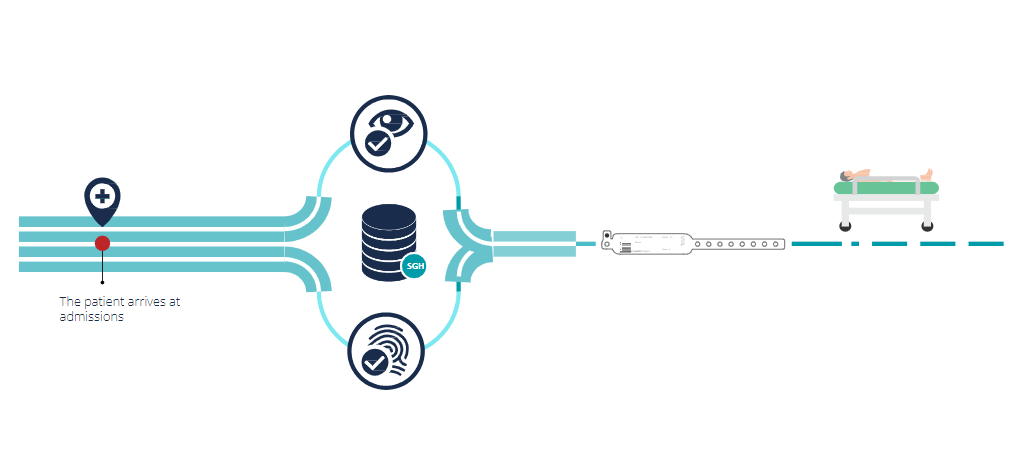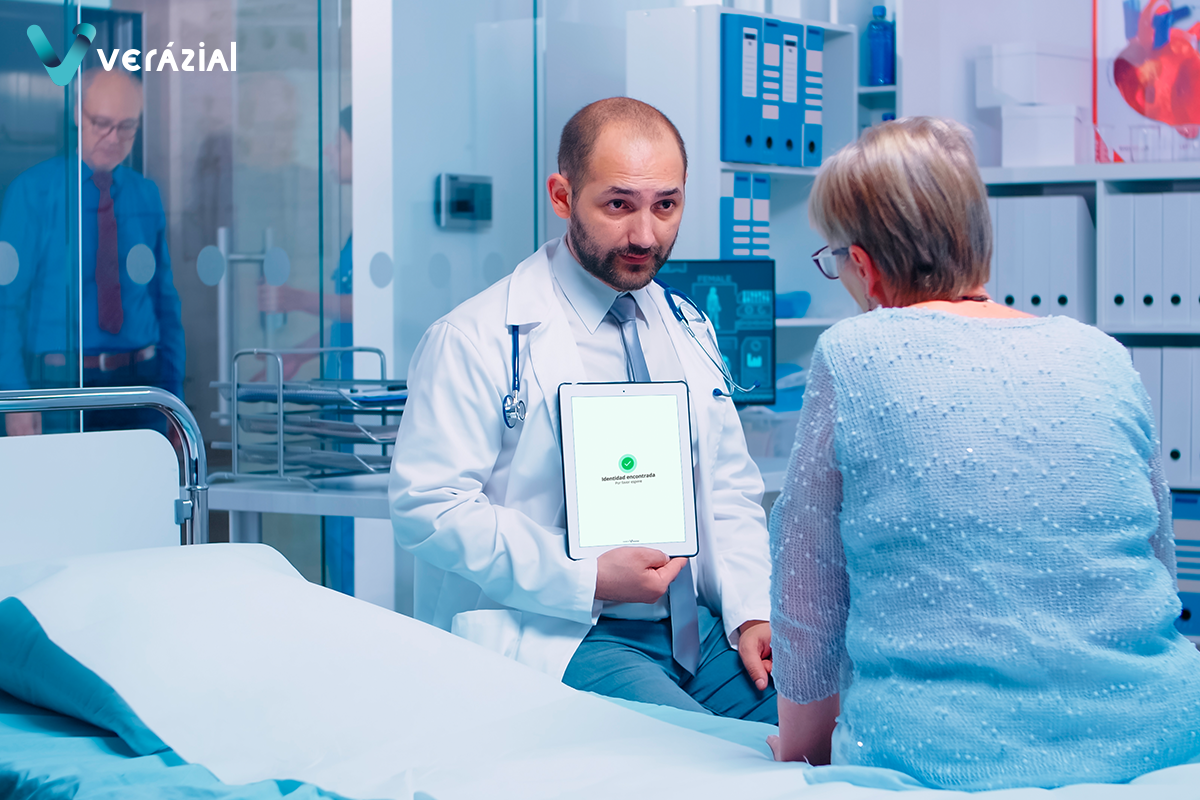Use of biometrics to improve patient safety
In healthcare, errors in patient identification can cause significant damage. Adopting biometric technologies, such as iris or fingerprint recognition, is presented as an effective solution providing multiple benefits that guarantee accurate and secure identification in hospitals.
The primary goal of healthcare is to provide medical care to those who require it, but this task continues to face numerous challenges in daily practice. Mistakes are still made that harm patients, with significant human, moral, ethical and economic consequences. These harms, often avoidable, have a significant impact on the health, well-being and safety of patients, undermining public confidence and increasing healthcare costs.
Patient safety focuses on eliminating avoidable harm and reducing the risk of unnecessary harm during medical care. To achieve this, it is necessary to implement a series of organized activities that establish processes, value systems, procedures, behaviors, technologies and care environments aimed at continuously reducing risks, preventing avoidable harm, reducing the likelihood of its occurrence and mitigating its effects when it does occur.
Common causes of patient harm include errors in prescribing medications, failures during surgical interventions, hospital-acquired infections, diagnostic errors, unsafe practices in blood transfusion and injection administration, as well as errors in patient identification.
Accurate patient identification is a fundamental pillar in ensuring patient safety. It is essential that patients are correctly identified at all times, and that active verification is a constant routine for all professionals involved in their hospital care.
Current measures to identify patients include the implementation of wristbands or bracelets, the use of two different identifiers (such as first and last name), staff training and the definition of clear protocols, among others.
However, unintentional errors persist due to insufficient security in the verification of patient identity. Although the use of bracelets is useful, it does not completely eliminate identification errors and their consequences, such as: damage to the patient’s health, identity theft fraud, increased economic costs, secondary victims and loss of prestige for the hospital and its medical staff. You will find more information on this subject in our article Patient identification in the healthcare environment.
How to ensure accurate patient identification?
The most efficient solution is to adopt biometric technologies to ensure accurate patient identification for all required medical procedures.
This technology relies on the unique and distinctive characteristics of our body, such as fingerprints, face or irises, to establish accurate patient identification.
The process is simple, upon arrival at the hospital, patients are identified using biometric technology, such as fingerprints or iris scans, during the admission process. From this point on, the medical staff verifies the patient’s identity using the same technology before performing any medical procedure. This system, integrated with hospital software, ensures simple, accurate and secure identification.
Although biometric identification is not required at all points in the hospital, it is highly recommended to implement it at least at those critical points where an error could have serious consequences for the patient’s health. These points include the admission process, prior to invasive medical procedures such as chemotherapy, radiotherapy, surgery, administration of sensitive medications and dialysis, among others.
Biometric identifications can be carried out from any device within the hospital, be it a computer, tablet or smartphone, as long as they are connected to the appropriate biometric sensors. This provides flexibility and ease of access to the identification system in all areas of the hospital.
Benefits of implementing biometric technology in hospitals

The implementation of this type of technology brings with it a number of significant benefits that go beyond the mere identification of patients and staff.
- It completely eliminates the risk of harm to patients’ health due to errors in patient identification. This ensures safer and more accurate medical care, as each patient is correctly identified before receiving any type of medical treatment or procedure.
- Helps eliminate 100% duplicate medical records. This redundancy in medical records can lead to treatment confusion, misdiagnosis and inefficient management of patient information. Having a biometric identification system ensures that each patient has a single, complete and up-to-date medical record, which improves the quality of medical care and coordination between different health services.
- Prevent identity fraud 100%. Identity fraud in healthcare can have serious financial and medical repercussions. By using unique biological characteristics, the possibility of identity theft is drastically reduced, which in turn protects health insurers’ resources and ensures fair and accurate distribution of medical services.
- Generates significant economic savings. By reducing the incidence of medical and administrative errors, costs associated with inadequate medical care, incorrect treatments and inefficient management of patient information are minimized. In addition, by preventing identity fraud, costs associated with the investigation and resolution of fraudulent claims are reduced.
- It contributes to the prevention of second victims in the health field. These second victims are the medical and nursing staff involved in medical incidents. After making a mistake, it is common for healthcare professionals to experience feelings of guilt, anxiety and stress.
In a future post, we will explore in detail the benefits of biometric technology to improve the operational efficiency and work experience of healthcare workers.
Find out how Verázial ID Health can help you ensure patient identification.
Contact us for a demonstration and/or personalized study.
References
- Elderly woman with a walker in the hospital waiting room. [Freepik]
Use of biometrics to improve patient safety
In healthcare, errors in patient identification can cause significant damage. Adopting biometric technologies, such as iris or fingerprint recognition, is presented as an effective solution providing multiple benefits that guarantee accurate and secure identification in hospitals.
The primary goal of healthcare is to provide medical care to those who require it, but this task continues to face numerous challenges in daily practice. Mistakes are still made that harm patients, with significant human, moral, ethical and economic consequences. These harms, often avoidable, have a significant impact on the health, well-being and safety of patients, undermining public confidence and increasing healthcare costs.
Patient safety focuses on eliminating avoidable harm and reducing the risk of unnecessary harm during medical care. To achieve this, it is necessary to implement a series of organized activities that establish processes, value systems, procedures, behaviors, technologies and care environments aimed at continuously reducing risks, preventing avoidable harm, reducing the likelihood of its occurrence and mitigating its effects when it does occur.
Common causes of patient harm include errors in prescribing medications, failures during surgical interventions, hospital-acquired infections, diagnostic errors, unsafe practices in blood transfusion and injection administration, as well as errors in patient identification.
Accurate patient identification is a fundamental pillar in ensuring patient safety. It is essential that patients are correctly identified at all times, and that active verification is a constant routine for all professionals involved in their hospital care.
Current measures to identify patients include the implementation of wristbands or bracelets, the use of two different identifiers (such as first and last name), staff training and the definition of clear protocols, among others.
However, unintentional errors persist due to insufficient security in the verification of patient identity. Although the use of bracelets is useful, it does not completely eliminate identification errors and their consequences, such as: damage to the patient’s health, identity theft fraud, increased economic costs, secondary victims and loss of prestige for the hospital and its medical staff. You will find more information on this subject in our article Patient identification in the healthcare environment.
How to ensure accurate patient identification?
The most efficient solution is to adopt biometric technologies to ensure accurate patient identification for all required medical procedures.
This technology relies on the unique and distinctive characteristics of our body, such as fingerprints, face or irises, to establish accurate patient identification.
The process is simple, upon arrival at the hospital, patients are identified using biometric technology, such as fingerprints or iris scans, during the admission process. From this point on, the medical staff verifies the patient’s identity using the same technology before performing any medical procedure. This system, integrated with hospital software, ensures simple, accurate and secure identification.
Although biometric identification is not required at all points in the hospital, it is highly recommended to implement it at least at those critical points where an error could have serious consequences for the patient’s health. These points include the admission process, prior to invasive medical procedures such as chemotherapy, radiotherapy, surgery, administration of sensitive medications and dialysis, among others.
Biometric identifications can be carried out from any device within the hospital, be it a computer, tablet or smartphone, as long as they are connected to the appropriate biometric sensors. This provides flexibility and ease of access to the identification system in all areas of the hospital.
Benefits of implementing biometric technology in hospitals

The implementation of this type of technology brings with it a number of significant benefits that go beyond the mere identification of patients and staff.
- It completely eliminates the risk of harm to patients’ health due to errors in patient identification. This ensures safer and more accurate medical care, as each patient is correctly identified before receiving any type of medical treatment or procedure.
- Helps eliminate 100% duplicate medical records. This redundancy in medical records can lead to treatment confusion, misdiagnosis and inefficient management of patient information. Having a biometric identification system ensures that each patient has a single, complete and up-to-date medical record, which improves the quality of medical care and coordination between different health services.
- Prevent identity fraud 100%. Identity fraud in healthcare can have serious financial and medical repercussions. By using unique biological characteristics, the possibility of identity theft is drastically reduced, which in turn protects health insurers’ resources and ensures fair and accurate distribution of medical services.
- Generates significant economic savings. By reducing the incidence of medical and administrative errors, costs associated with inadequate medical care, incorrect treatments and inefficient management of patient information are minimized. In addition, by preventing identity fraud, costs associated with the investigation and resolution of fraudulent claims are reduced.
- It contributes to the prevention of second victims in the health field. These second victims are the medical and nursing staff involved in medical incidents. After making a mistake, it is common for healthcare professionals to experience feelings of guilt, anxiety and stress.
In a future post, we will explore in detail the benefits of biometric technology to improve the operational efficiency and work experience of healthcare workers.
Find out how Verázial ID Health can help you ensure patient identification.
Contact us for a demonstration and/or personalized study.
References
- Elderly woman with a walker in the hospital waiting room. [Freepik]
Use of biometrics to improve patient safety
In healthcare, errors in patient identification can cause significant damage. Adopting biometric technologies, such as iris or fingerprint recognition, is presented as an effective solution providing multiple benefits that guarantee accurate and secure identification in hospitals.
The primary goal of healthcare is to provide medical care to those who require it, but this task continues to face numerous challenges in daily practice. Mistakes are still made that harm patients, with significant human, moral, ethical and economic consequences. These harms, often avoidable, have a significant impact on the health, well-being and safety of patients, undermining public confidence and increasing healthcare costs.
Patient safety focuses on eliminating avoidable harm and reducing the risk of unnecessary harm during medical care. To achieve this, it is necessary to implement a series of organized activities that establish processes, value systems, procedures, behaviors, technologies and care environments aimed at continuously reducing risks, preventing avoidable harm, reducing the likelihood of its occurrence and mitigating its effects when it does occur.
Common causes of patient harm include errors in prescribing medications, failures during surgical interventions, hospital-acquired infections, diagnostic errors, unsafe practices in blood transfusion and injection administration, as well as errors in patient identification.
Accurate patient identification is a fundamental pillar in ensuring patient safety. It is essential that patients are correctly identified at all times, and that active verification is a constant routine for all professionals involved in their hospital care.
Current measures to identify patients include the implementation of wristbands or bracelets, the use of two different identifiers (such as first and last name), staff training and the definition of clear protocols, among others.
However, unintentional errors persist due to insufficient security in the verification of patient identity. Although the use of bracelets is useful, it does not completely eliminate identification errors and their consequences, such as: damage to the patient’s health, identity theft fraud, increased economic costs, secondary victims and loss of prestige for the hospital and its medical staff. You will find more information on this subject in our article Patient identification in the healthcare environment.
How to ensure accurate patient identification?
The most efficient solution is to adopt biometric technologies to ensure accurate patient identification for all required medical procedures.
This technology relies on the unique and distinctive characteristics of our body, such as fingerprints, face or irises, to establish accurate patient identification.
The process is simple, upon arrival at the hospital, patients are identified using biometric technology, such as fingerprints or iris scans, during the admission process. From this point on, the medical staff verifies the patient’s identity using the same technology before performing any medical procedure. This system, integrated with hospital software, ensures simple, accurate and secure identification.
Although biometric identification is not required at all points in the hospital, it is highly recommended to implement it at least at those critical points where an error could have serious consequences for the patient’s health. These points include the admission process, prior to invasive medical procedures such as chemotherapy, radiotherapy, surgery, administration of sensitive medications and dialysis, among others.
Biometric identifications can be carried out from any device within the hospital, be it a computer, tablet or smartphone, as long as they are connected to the appropriate biometric sensors. This provides flexibility and ease of access to the identification system in all areas of the hospital.
Benefits of implementing biometric technology in hospitals

The implementation of this type of technology brings with it a number of significant benefits that go beyond the mere identification of patients and staff.
- It completely eliminates the risk of harm to patients’ health due to errors in patient identification. This ensures safer and more accurate medical care, as each patient is correctly identified before receiving any type of medical treatment or procedure.
- Helps eliminate 100% duplicate medical records. This redundancy in medical records can lead to treatment confusion, misdiagnosis and inefficient management of patient information. Having a biometric identification system ensures that each patient has a single, complete and up-to-date medical record, which improves the quality of medical care and coordination between different health services.
- Prevent identity fraud 100%. Identity fraud in healthcare can have serious financial and medical repercussions. By using unique biological characteristics, the possibility of identity theft is drastically reduced, which in turn protects health insurers’ resources and ensures fair and accurate distribution of medical services.
- Generates significant economic savings. By reducing the incidence of medical and administrative errors, costs associated with inadequate medical care, incorrect treatments and inefficient management of patient information are minimized. In addition, by preventing identity fraud, costs associated with the investigation and resolution of fraudulent claims are reduced.
- It contributes to the prevention of second victims in the health field. These second victims are the medical and nursing staff involved in medical incidents. After making a mistake, it is common for healthcare professionals to experience feelings of guilt, anxiety and stress.
In a future post, we will explore in detail the benefits of biometric technology to improve the operational efficiency and work experience of healthcare workers.
Find out how Verázial ID Health can help you ensure patient identification.
Contact us for a demonstration and/or personalized study.
References
- Elderly woman with a walker in the hospital waiting room. [Freepik]
You May Also Like
You May Also Like





